US Government, The Department of Defense's (DOD) intelligence, surveillance, and reconnaissance (ISR) capabilities-such as satellites and unmanned aircraft systems-are crucial to military operations, and demand for ISR capabilities has increased. For example, DOD plans to invest $28 billion over the next 7 years in 20 airborne ISR systems alone.
Congress directed DOD to fully integrate its ISR capabilities, also known as the ISR enterprise, as it works to meet current and future ISR needs. GAO was asked to (1) describe the challenges, if any, that DOD faces in integrating its ISR enterprise, (2) assess DOD's management approach for improving integration of its future ISR investments, and (3) evaluate the extent to which DOD has implemented key activities to ensure proposed new ISR capabilities fill gaps, are not duplicative, and use a joint approach to meeting warfighters' needs.
GAO assessed DOD's integration initiatives and 19 proposals for new ISR capabilities. We supplemented this analysis with discussions with DOD officials.
DOD faces a complex and challenging environment in supporting defense requirements for ISR capabilities as well as national intelligence efforts. Past efforts to improve integration across DOD and national intelligence agencies have been hampered by the diverse missions and different institutional cultures of the many intelligence agencies that DOD supports.
For example, DOD had difficulty obtaining complete information on national ISR assets that could support military operations because of security classifications of other agency documents. Further, different funding arrangements for defense and national intelligence activities complicate integration of interagency activities. While DOD develops the defense intelligence budget, some DOD activities also receive funding through the national intelligence budget to provide support for national intelligence efforts. Disagreements about equitable funding from each budget have led to program delays.
Separate military and intelligence requirements identification processes also complicate efforts to integrate future ISR investments. DOD does not have a clearly defined vision of a future ISR enterprise to guide its ISR investments.
DOD has taken a significant step toward integrating its ISR activities by developing an ISR Integration Roadmap that includes existing and currently planned ISR systems. However, the Roadmap does not provide a long-term view of what capabilities are required to achieve strategic goals or provide detailed information that would make it useful as a basis for deciding among alternative investments.
Without a clear vision of the desired ISR end state and sufficient detail on existing and planned systems, DOD decision makers lack a basis for determining where additional capabilities are required, prioritizing investments, or assessing progress in achieving strategic goals, as well as identifying areas where further investment may not be warranted.
DOD policy calls for the services and agencies that sponsor proposals for new ISR capabilities to conduct comprehensive assessments of current and planned ISR systems, but GAO's review of 19 proposals showed that 12 sponsors did not complete assessments, and the completeness of the remaining 7 sponsors' assessments varied.
GAO found that the DOD board charged with reviewing ISR proposals did not consistently co-ordinate with sponsors to ensure the quality of the assessments supporting their proposals or review the completed assessments. There were three key reasons for this. First, the board did not have a comprehensive, readily available source of information about existing and developmental ISR capabilities that could help identify alternatives to new systems. Second, the board has no monitoring mechanism to ensure that key activities are fully implemented. Third, DOD board officials said that the board lacks adequate numbers of dedicated, skilled personnel to engage in early coordination with sponsors and to review sponsors' assessments.
Without more complete information on alternatives and a monitoring mechanism to ensure these key activities are fully implemented, DOD is not in the best position to ensure that investment decisions are consistent with department-wide priorities.
Full report is on US Government Accountability Office website in PDF format.









